The date was July 17, 1944. The place: the munitions facility at Port Chicago, California, 35 miles north of San Francisco. Black Navy personnel units had been assigned to the dangerous work of loading munitions, with loading happening around the clock.
On the evening of July 17, empty merchant ship SS Quinault Victory was prepared for loading on her maiden voyage. The SS E.A. Bryan, another merchant ship, had just returned from her first voyage and was loading across the platform from Quinault Victory. The holds were packed with high explosive and incendiary bombs, depth charges and ammunition -- 4,606 tons of ammunition in all. There were 16 rail cars on the pier with another 429 tons. Working in the area were 320 cargo handlers, crewmen and sailors.
At 10:18 p.m., an explosion ripped apart the night sky. Witnesses said that a brilliant white flash shot into the air, accompanied by a loud, sharp report. Flashing like fireworks, smaller explosions went off in the cloud as it rose. Within six seconds, a deeper explosion erupted as the contents of the E.A. Bryan detonated in one massive explosion. The seismic shock wave was felt as far away as Boulder City, Nevada.
The E.A. Bryan and the structures around the pier were completely disintegrated. A pillar of fire and smoke stretched more than two miles into the sky above Port Chicago. The largest remaining pieces of the 7,200-ton ship were the size of a suitcase. A plane flying at 9,000 feet reported seeing chunks of white hot metal "as big as a house" flying past. The shattered Quinault Victory was spun into the air. Witnesses reported seeing a 200-foot column on which rode the bow of the ship, its mast still attached. Its remains crashed back into the bay 500 feet away.
All 320 men on duty that night were killed instantly. The blast smashed buildings and rail cars near the pier and damaged every building in Port Chicago. People on the base and in town were sent flying or were sprayed with splinters of glass and other debris. The air filled with the sharp cracks and dull thuds of smoldering metal and unexploded shells as they showered back to Earth as far as two miles away. The blast caused damage 48 miles across the bay in San Francisco.

Damage at Port Chicago following the massive blast that killed 320 sailors. The remnants of the SS Quinault Victory appear in the background.
The disaster sparked controversy in its aftermath. It was determined that inadequate training, hazardous conditions and irresponsible labor practices contributed to the disaster. Many of the surviving sailors felt that their commanders had not properly addressed these issues when they asked them to continue to work. In response, they protested with a work stoppage.
Although no violence or threat of violence occurred, the Navy viewed the work stoppage as a mutiny. In September 1944, the Navy charged 50 of the Port Chicago sailors with disobeying orders and initiating a mutiny. A court-martial found them guilty in October.
The disaster at Port Chicago and its aftermath are important moments in Black history. The events caught the attention of civil rights activist and chief counsel of the NAACP, Thurgood Marshall. He believed that the court-martial unjustly charged the sailors with mutiny.
Furthermore, he called for a government investigation of the Navy’s practice of assigning Black service members to segregated support roles, as well as the unsafe conditions in which the sailors worked. Bringing national attention to these issues contributed to the executive order that desegregated the military in 1948. The legacies of the Port Chicago sailors still resonate today.
The 50 sailors from Port Chicago charged with mutiny appear at their court-martial in 1944.
Many of the sailors who died in the Port Chicago disaster are now buried at Golden Gate National Cemetery. Last year, the Veterans Legacy Program partnered with San Francisco State University to conduct research on veterans buried at local national cemeteries. The students and faculty created a series of short films about the stories that they discovered at Golden Gate and San Francisco national cemeteries. One of the films (embedded above) highlights the Port Chicago disaster and shares the legacies that came from it.
This partnership is one of the ongoing efforts to modernize the way that we memorialize veterans. In May 2016, the National Cemetery Administration launched the Veterans Legacy Program in order to engage students, teachers, and the public with stories about the lives and service of Veterans. To find out more about the Veterans Legacy Program, visit www.cem.va.gov/legacy/
More information about the Port Chicago disaster: Naval History and Heritage Command
Want to Know More About the Military?
Be sure to get the latest news about the U.S. military, as well as critical info about how to join and all the benefits of service. Subscribe to Military.com and receive customized updates delivered straight to your inbox.















